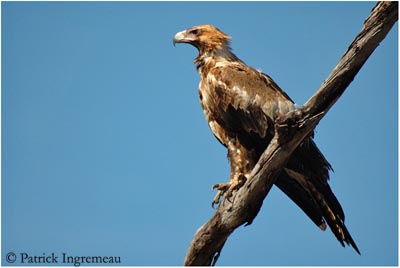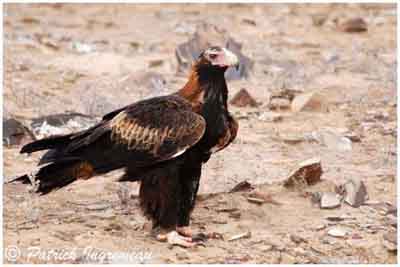
Wedge-tailed Eagle
Aquila audax
Accipitriforme Order – Accipitridae Family
BIOMETRICS:
Length: 90-110 cm; Wingspan: 180-250 cm; Weight: M: 3,2 to 4 kg; F: 4,2 to 5,3 kg.
LONGEVITY: 25 years
DESCRIPTION:
Wedge-tailed eagle is a very large raptor.
Adult is dark blackish-brown. Female is slightly paler. Sexes are similar, but female is larger than male.
Bill is pale pink to cream or grey, becoming darker towards the tip. Base of bill is yellow. Legs are feathered, and feet are pale yellow, with black claws.
Wedge-tailed eagle has long wings, and a typical long, wedge-shaped tail.
Young eagles have dark brown or black plumage, with some rufous-tinged feathers on nape and wings. They become darker or blacker progressively, during the first 10 years of their lives. They are almost entirely black at 7 years.
VOICE:
Wedge-tailed eagle’s calls are whistling and loud shrill screams. Its calls are quite weak for the size of the bird.
HABITAT:
Wedge-tailed eagle is found from sea level to mountainous regions. It lives in woodlands and open countries, but it avoids rainforest and coastal areas. It likes open woodland areas with good grassy cover. It is uncommon in Australian deserts.
RANGE:
Wedge-tailed eagle lives mainly in Australia. We can find small populations in Tasmania and Southern New Guinea.
BEHAVIOUR:
Wedge-tailed eagle soars making circles, flying near the ground, or from a perch, to search a prey. It can seize living preys like a young kangaroo or an ibis. In pasture areas, its preys are mostly rabbits and hares, although they kill sometimes lambs or young goats.
REPRODUCTION:
Wedge-tailed eagle’s nest is very bulky. It is built by both parents, in a place allowing a good view of the surrounding countryside. It may be located in dead or live tall tree, or in small trees, shrubs, cliff faces, or even on the ground.
Nest is made with dead wood sticks. It is a big structure of almost 2 metres wide, 3 metres high and about 400 kg weight. On the top of the nest, we find a shallow cup, lined with fresh twigs and leaves.
Between April and September, female lays 1 to 3 white eggs, spotted and blotched with reddish-brown, at intervals of 2 to 4 days between each egg. Incubation lasts about 42 to 48 days, beginning with the first egg laid. Both parents share it.
First chick hatches larger than second and third. Their lives depend on conditions, food resources and disturbances around the nest site.
Usually, a pair keeps only one young, but in some good years, we can see two chicks fledging in same nest. They fledge at about 70 to 95 days.
The oldest chick is larger than the other, and has more chance to live. If food is not enough, it kills the smaller to eat.
Chicks are covered with white down. Both parents feed them, first, giving them food to their mouths, and then, chicks can feed themselves on the floor of the nest.
They reach the first feathers 10 to 15 days after hatching.
If an intruder threats the young, it lies flat on the floor of the nest, but it is able to defend itself, because parents do little to defend it.
Juveniles and adults remain together during 11 to 12 weeks after fledging, and after this period, they move or disperse to other places.
Fr: Aigle d’Australie
All : Keilschwanzadler
Esp : Águila Audaz
Ital : Aquila codacuneata
Nd : Wigstaartarend
Russe : Австралийский клинохвостый орёл
Patrick Ingremeau
TAMANDUA
Text by Nicole Bouglouan
Sources :
L’ENCYCLOPEDIE MONDIALE DES OISEAUX - Dr Christopher M. Perrins - BORDAS - ISBN: 2040185607
LES AIGLES par Maurice Dupérat - Artémis Editions - ISBN: 2844164536
Wikipedia (Wikipedia, The Free Encyclopedia)
Birds in backyards (Birds Australia and Australian Museum)
The Hawk Conservancy Trust (Hilary Smith)
Arthur Grosset's Birds (Arthur Grosset)

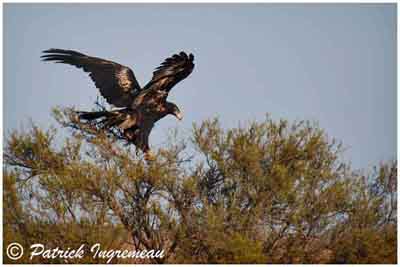
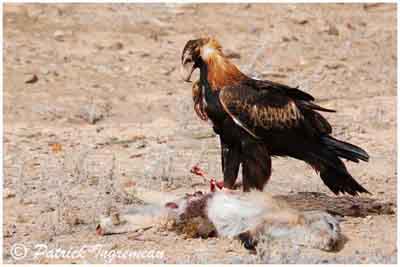
Juveniles often feed on carrion, and they gather like vultures around carcasses of dead animals on the roadsides. Up to 20 birds can be seen near a carcass, but only 2 or 3 can feed at the same time.
This eagle is a diurnal bird of prey. It hunts solitary, or in pair, or in larger groups. When they hunt together, they can kill larger animals, as adult kangaroos. Wedge-tailed eagle is able to lift 50% of its own weight. It has very keen eyesight, and it can see in two ways, the whole countryside and a small part of it as with a telescope. Eagles often are perched on tall trees or poles.
Flight displays are wonderful. Pairs perform gliding flights making circles, undulating flights, other figures where one bird returns on the back to present its talons to the other. They are monogamous and mate for life.
Number of active nests depends of food resources. Generally, nests are 2, 5 to 4 km apart. If food resources are important, we can find nests at less than one km apart.
Wedge-tailed eagles are very territorial birds. They defend their nest site area from other eagles, but also from several kinds of intruders such as small airplanes, gliders and others.
FLIGHT:
Wedge-tailed eagle soars at great height in the sky (6000 feet), and it is difficult to see it. It has an agile flight, allowing acrobatic aerial displays. They are highly aerial, soaring for hours without wing beats or effort. It soars with raised wings. It flies with slow powerful wing beats in the air currents.
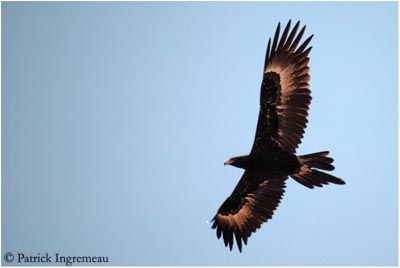
DIET:
Wedge-tailed eagle feeds mainly on carrion. The most important living preys are rabbits and hares. They also consume lizards, birds and mammals. They kill sometimes lambs and young goats, but it is a small percentage of their preys.
PROTECTION / THREATS /STATUS:
The small population of Tasmania is threatened by habitat destruction and persecutions.
For the other populations, indirect poisoning and pesticides are a major threat.
Wedge-tailed eagle is sensitive to forestry operations, when extensive clearing reduce nesting resources.
It is protected by the National Parks and Wildlife Service. It is now illegal to kill, trap, poison or interfere with them in any way.
Wedge-tailed eagle is the emblem of Australia’s Northern Territory.
